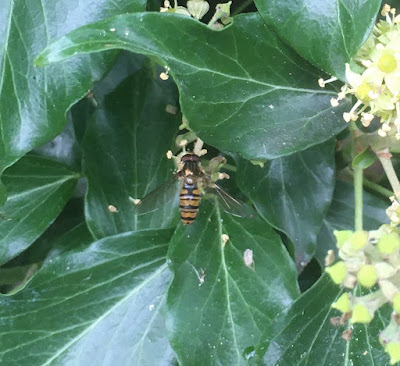My October article for The Tees Online has just been published (https://thetees.online/ivy-villain-or-hero/) but to make it easier for you, here is the text plus a few more photos.
"October Nature: Ivy - Hero or Villain?
What comes to mind when you think of Ivy? For many people it will bring up images of a pesky climbing weed that strangles trees, damages walls and fences and is no good for anything.
In fact Ivy, or Hedera helix to give it its scientific name, is a wonderful and unjustly vilified plant that is great for wildlife in many different ways.
Firstly, because it flowers in autumn it is a very important source of nectar for many species of insect at a time of year when few other plants are flowering and insects would really struggle without it. Although the flowers are more inconspicuous than those of many species, being mostly pale green and lacking petals, a small patch of ivy can have hundreds of flower heads and provides food for large numbers of bees, wasps, hoverflies, butterflies and many other insects.
 |
The insignificant looking flowers of Ivy are a rich source of nectar for insects late in the year in the UK |
 |
Many species of hoverflies, some of which have evolved to look like wasps to scare off potential predators, feed on Ivy flowers in the autumn |
Later in the winter the flowers will develop into black berries which will help birds such as Blackbirds, Woodpigeons, Redwings and Fieldfares (the last two being migratory members of the Thrush family) survive the harshest months of the year.
In the winter months, patches of ground covered in Ivy may remain frost free when nearby areas are frozen solid. This allows birds and small mammals to continue searching for food in the leaf litter during icy weather. Also, its twisting, intertwining branches and stems, and its evergreen leaves, create many niches and hollows in which birds and other animals such as Wood Mice can find shelter from severe weather. In the spring and summer many birds build their nests in ivy to raise their young.
The commonest accusation levelled against this great plant is that it strangles trees. Ivy uses trees, to give it support and allow it to reach up towards the sunlight but it is not a parasite which feeds off them (unlike another, much more popular, evergreen plant - Mistletoe), and its presence is not a sign of an unhealthy tree. However, trees don’t live forever and have a natural life cycle involving different stages. Ivy will sometimes play a role in helping an old tree move along this continuum, from the vertical to the horizontal, as it were, and may bring trees down by acting as a sail during high winds, or by holding a great weight of snow after blizzards. This still doesn’t mean that Ivy is a villain though, as dead wood is an important part of a woodland ecosystem and the toppling of trees opens up the canopy, allowing sunlight to reach the forest floor and exposing bare soil. This lets plants and animals flourish that otherwise wouldn’t be able to compete.
But surely Ivy is still bad for buildings, I hear you say. Well, a three year study carried out jointly by Oxford University and English Heritage showed that, while it could make existing damage worse, it also had a positive effect in some cases by keeping walls warmer in the winter and cooler in the summer and by protecting them from salt and airborne pollution.
 |
The familiar lobed leaves, which give the name to several
other unrelated plants (such as Ivy-leaved Toadflax
and Ivy-leaved Speedwell) are found on young plants only.
More mature plants have simple oval-shaped leaves
Finally, Ivy features prominently in folklore. Bacchus, the Roman god of wine, the grape-harvest and fertility, is often depicted wreathed in Ivy as well as the more predictable grape-vines. It also symbolised intellectual prowess in ancient Rome and Ivy wreaths were given to the winners of poetry contests. It was also a symbol of fidelity and even today it is common for bridal bouquets to contain a sprig of this amazing, interesting and important evergreen plant."
 |
| The oval shape of the leaves, as well as the presence of flowers, shows that this is a mature Ivy plant |
 |
| A Honey-bee (Apis mellifera) feeding on Ivy flowers |
 |
| Ivy berries just starting to form. Later in the Winter these will be black |
No comments:
Post a Comment